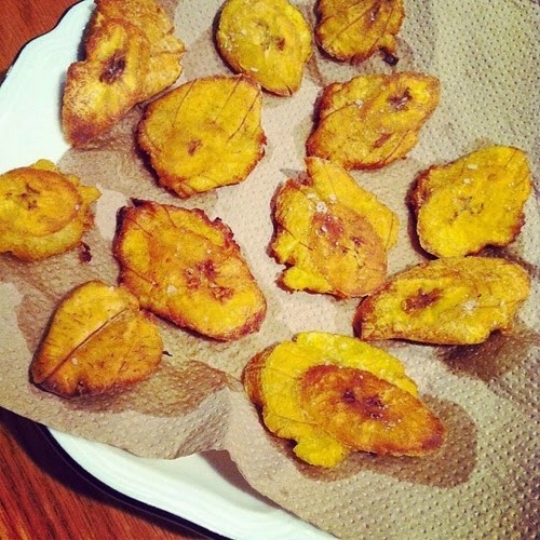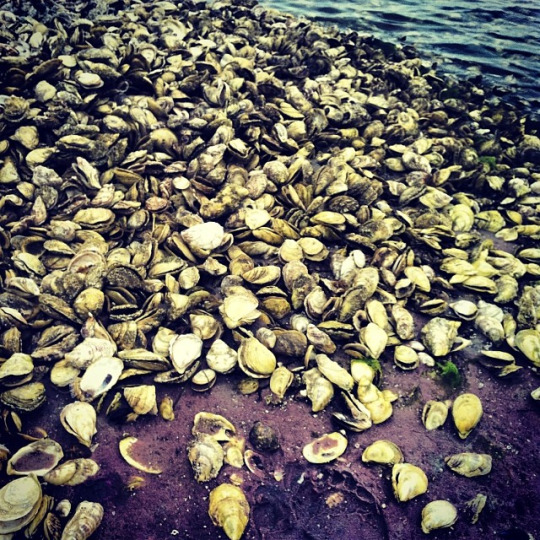Tostones: Slice, Soak, Fry, Smash, Fry
As far as I can tell, there are a few helpful rules to follow when having company for dinner. Salty pig parts rarely disappoint. Dessert should be mandatory, for both hosts and guests. And if you can fry something without making your companions feel as though everyone has entered the seventh circle of hell, you will be a champion.
Frying food is not easy. It is violent. Hot oil gurgles and bubbles and erratically catapults towards the stove, the walls, your eyes. Always the eyes.
I went through a phase in my twenties when I fried a lot of sad, white fish. Tilapia was very cheap. I was broke. Amazing what a saltwater soak, some Tabasco, and a double dip in flour could do.
Though one time I served this fish camouflage with slightly raw insides to an old boyfriend’s family and everyone ate very quietly and politely while I melted into the carpet. Luckily, no one died.
The point is, I have the recipe written down somewhere in a splattered kitchen notebook. It is worthy of company. And I have not made it in over five years. Because frying things—and I like to think I am not alone here—usually makes me feel like hell.
But this is not the case for all. For instance, if you are a certain hot-blooded Puerto Rican, you might set down a plate of sexy fried things looking like you’ve just woken from a nap in a meadow. Which is what happened when my friend Thais and her husband Dave invited me over for dinner a few months ago.
Appropriate rules were followed. They served a big, brilliant plate of bacon rice studded with peas and carrots and seasoned with culantro sofrito. Collectively, dinner guests pillaged a quart of coconut ice cream. And Thais taught me how to make tostones, and made it look effortless.
In truth, tostones really aren’t really a nefarious endeavor. There is some oil splattering, to be sure, but no breading to deal with. And the risk of involvement from the Centers for Disease Control is incredibly low.
They are made from green plantains, which are like starchy bananas. Tossing them in oil makes them irrationally more redeemable than French fries—though just as addictive. Essentially, you slice, soak, fry, smash, and fry again.
And then you eat with a mayo or sour cream-based condiment of choice. Thais has childhood roots in mayo and ketchup. I’ve fiddled with the addition of chili garlic sauce and lime. Some minced fresh oregano would be lovely too, I’m sure.
Don’t let the sauce or the splatter deter you. They can be made without too much difficulty. You too can avoid the inferno.
Tostones
Ingredients:
- 1 large garlic clove, minced
- kosher salt
- 3 green plantains
- canola oil (enough to fill an inch or so up the sides of a pan at least 10 inches wide and 3 inches deep)
- coarse sea salt (kosher works in a pinch)
Instructions:
Prepare a large bowl of water (temperature does not really matter, just not too hot or cold). Add in the garlic and a few pinches of kosher salt.
Take one plantain and, with a sharp knife, slice the peel lengthwise, cutting into the peel but not the flesh. Cut two more lengthwise slits at equal intervals so the peel is segmented in three places (this will make it easier to remove). Wedge your thumb under between the peel and the flesh of the plantain and gently slide it down to remove each section of the peel. Repeat with the remaining plantains.
Cut the plantains into ½ inch diagonal slices and toss them into the seasoned water; let sit for at least 10 minutes or up to an hour.
When you are ready to fry, pour the oil into a large, deep pan; fill at least 1 inch deep and heat on medium high. (The oil is ready when it sizzles when a piece of bread is dipped in.)
Set in as many slices as you can without overcrowding the pan. Turn them over when their bottoms turn bright yellow and start to get crispy; repeat with the other side (this will take about 3 minutes per side).
One fried on both sides, place the slices on a large board and repeat with the remaining slices.
After the first frying, use the bottom of a sturdy glass to press down heavily to smash each slice.
Dip the smashed slices in water, press a few bits of salt on one side, step back to avoid the splatter, and then fry the slices again on both sides until crispy and golden (1 to 2 minutes per side).
Makes about 15 or 20 tostones
Notes:
- This can be done with more than 3 plantains, but the amount listed is enough for 3 or 4 people to have as a snack.
- For this you do not want the yellow, ripe plantains; they’ll be too sweet.
- These are best the day they are made, but they can be warmed in 350 degree oven for 5 to 10 minutes.









